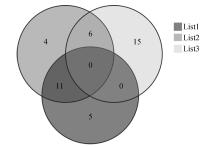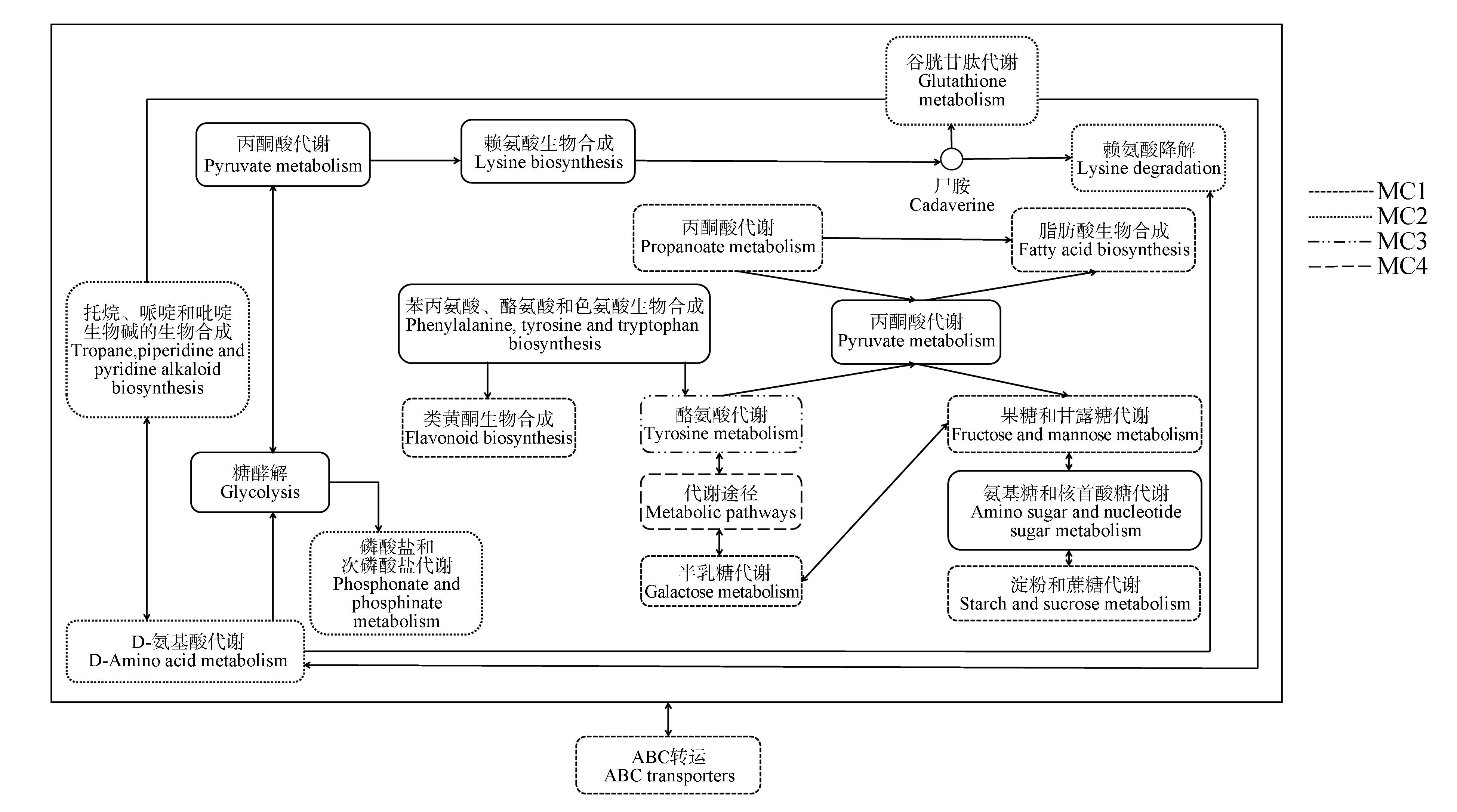Bulletin of Botanical Research ›› 2024, Vol. 44 ›› Issue (5): 793-804.doi: 10.7525/j.issn.1673-5102.2024.05.016
• Molecular biology • Previous Articles
Zhiyuan CHENG1, Yanjiang ZHANG1( ), Yue SHEN1, Guang LI2, Qin CHEN3, Jie LI2, Yanhong XING1
), Yue SHEN1, Guang LI2, Qin CHEN3, Jie LI2, Yanhong XING1
Received:2023-10-11
Online:2024-09-20
Published:2024-09-23
Contact:
Yanjiang ZHANG
E-mail:zhyjjdw@126.com
CLC Number:
Zhiyuan CHENG, Yanjiang ZHANG, Yue SHEN, Guang LI, Qin CHEN, Jie LI, Yanhong XING. Metabolomics Analysis of Lilium davidii var. unicolor in Response to Autotoxicity Stress[J]. Bulletin of Botanical Research, 2024, 44(5): 793-804.
Add to citation manager EndNote|Ris|BibTeX
URL: https://bbr.nefu.edu.cn/EN/10.7525/j.issn.1673-5102.2024.05.016

Fig.7
Venn plot of the number of differential metabo-lites shared among different groupsList1. Represented the differential metabolites between Lily1 and Lily2; List2. Represented the differential metabolites between Lily1 and Lily3; List3. Represented the differential metabolites between Lily2 and Lily3.


Fig.8
Metabolomics conjoint analysis results of Lilium davidii var. unicolor in different growth yearsMC1. Represented the shared differential metabolic pathways between List 1 and List 3;MC2. Represented the unique differential metabolic pathway of List 2;MC3. Represented the unique differential metabolic pathway of List1; MC4. Represented the shared differential metabolic pathways among List 1,List 2 and List 3; List1. Represented the differential metabolites between Lily1 and Lily2; List2. Represented the differential metabolites between Lily1 and Lily3; List3. Represented the differential metabolites between Lily2 and Lily3.

| 1 | SHANG Q H, ZHAO X, LI Y Y,et al.First report of Fusarium tricinctum causing stem and root rot on Lanzhou lily(Lilium davidii var.unicolor) in China[J].Plant Disease,2014,98(7):999. |
| 2 | MATSUO Y, TAKAKU R, MIMAKI Y.Novel steroidal glycosides from the bulbs of Lilium pumilum [J].Molecules,2015,20(9):16255-16265. |
| 3 | CHUNG I M, MILLER D A.Effect of alfalfa plant and soil extracts on germination and growth of alfalfa[J].Agronomy Journal,1995,87(4):762-767. |
| 4 | DONG Q F, CHENG Z H.Study on allelopathy of top part aqueous extracts of lily plant[J].Acta Agriculturae Boreali-Occidentalis Sinica,2006(2):144-147. |
| 5 | 董小艳,程智慧,张亮.百合根系分泌物对4种观赏植物的化感作用[J].西北农林科技大学学报(自然科学版),2008,36(9):113-117. |
| DONG X Y, CHENG Z H, ZHANG L.Allelopathy of lily root exudates on some receiver ornamental plants[J].Journal of Northwest A & F University(Natural Science Edition),2008,36(9):113-117. | |
| 6 | 李小玲,华智锐.百合不同器官水浸液对几种观赏植物的化感效应[J].山西农业科学,2015,43(11):1403-1407. |
| LI X L, HUA Z R.Allelopathy effect of aqueous extraction from different organs of lily on several of ornamental plants[J].Journal of Shanxi Agricultural Sciences,2015,43(11):1403-1407. | |
| 7 | 童晓翠,庞珂佳,王俊儒,等.卷丹鳞茎水浸提液对生菜化感作用的研究[J].西北林学院学报,2008,23(5):154-156. |
| TONG X C, PANG K J, WANG J R,et al.Allelopathic effect of the aqueous extracts from the bulbs of Lilium lancifolium on lettuce[J].Journal of Northwest Forestry University,2008,23(5):154-156. | |
| 8 | WU Z J, XIE Z K, YANG L,et al.Identification of autotoxins from root exudates of Lanzhou lily(Lilium davidii var.unicolor)[J].Allelopathy Journal,2015,35(1):35-48. |
| 9 | YAN Z Q, HE X F, GUO K,et al.Allelochemicals from the rhizosphere of Lanzhou lily:discovery of the autotoxic compounds of a bulb crop[J].Scientia Horticulturae,2019,250(7):121-126. |
| 10 | INDERJIT, KEATING K I.Allelopathy:principles,procedures,processes,and promises for biological control[M]//SPARKS D L.Advances in agronomy:Vol.67.San Diego:Academic Press,1999:141-231. |
| 11 | WU B, LONG Q L, GAO Y,et al.Comprehensive characterization of a time-course transcriptional response induced by autotoxins in Panax ginseng using RNA-Seq[J].BMC Genomics,2015,16:1010. |
| 12 | HUANG L F, SONG L X, XIA X J,et al.Plant-soil feedbacks and soil sickness:from mechanisms to application in agriculture[J].Journal of Chemical Ecology,2013,39:232-242. |
| 13 | CUI J J, ZHANG E H, ZHANG X H,et al.Effects of 2,4-di-tert-butylphenol at different concentrations on soil functionality and microbial community structure in the Lanzhou lily rhizosphere[J].Applied Soil Ecology,2022,172:104367. |
| 14 | YANG M, CHUAN Y C, GUO C W,et al. Panax notoginseng root cell death caused by the autotoxic ginsenoside Rg1 is due to over-accumulation of ROS,as revealed by transcriptomic and cellular approaches[J].Frontiers in Plant Science,2018,9:264. |
| 15 | LI Z F, HE C L, WANG Y,et al.Enhancement of trichothecene mycotoxins of Fusarium oxysporum by ferulic acid aggravates oxidative damage in Rehmannia glutinosa Libosch[J].Scientific Reports,2016,6:33962. |
| 16 | SINGH H P, BATISH D R, KOHLI R K.Autotoxicity:concept,organisms,and ecological significance[J].Critical Reviews in Plant Sciences,1999,18(6):757-772. |
| 17 | YUAN J, LIU R P, SHENG S S,et al.Integrated metabolomic and transcriptomic profiling revealed coping mechanisms of the edible and medicinal homologous plant Plantago asiatica L.cadmium resistance[J].Open Life Sciences,2022,17(1):1347-1359. |
| 18 | HOWE G A, JANDER G.Plant immunity to insect herbivores[J].Annual Review of Plant Biology,2008,59:41-66. |
| 19 | ZHANG W J, WANG S, YANG J,et al.Glycosylation of plant secondary metabolites:regulating from chaos to harmony[J].Environmental and Experimental Botany,2022,194:104703. |
| 20 | JANZEN D H.The ecology and evolutionary biology of seed chemistry as relates to seed predation[M]//HARBORNE J B.Biochemical aspects of plant and animal coevolution.New York:Academic Press,1978:163-206. |
| 21 | VON RAD U, HÜTTL R, LOTTSPEICH F,et al.Two glucosyltransferases are involved in detoxification of benzoxazinoids in maize[J].The Plant Journal,2001,28(6):633-642. |
| 22 | GHATAK A, CHATURVEDI P, WECKWERTH W.Metabolomics in plant stress physiology[M]//VARSHNEY R,PANDEY M,CHITIKINENI A.Plant genetics and molecular biology:Vol.164.Cham:Springer,2018:187-236. |
| 23 | Anonymous.Optimizing GC-MS methods[J].LCGC North America,2013,31(12):1026. |
| 24 | 潘曦,刘辉,王昊,等.基于近红外光谱和OPLS-DA的不同牌号卷烟分类识别方法研究[J].分析测试学报,2020,39(11):1385-1391. |
| PAN X, LIU H, WANG H,et al.Research on classification and recognition methods for different grades of cigarettes based on near-infrared spectroscopy and OPLS-DA[J].Journal of Instrumental Analysis,2020,39(11):1385-1391. | |
| 25 | WANG P J, GU M Y, SHAO S X,et al.Changes in non-volatile and volatile metabolites associated with heterosis in tea plants(Camellia sinensis)[J].Journal of Agricultural and Food Chemistry,2022,70(9):3067-3078. |
| 26 | YU J Q, MATSUI Y.Phytotoxic substances in root exudates of cucumber(Cucumis sativus L.)[J].Journal of Chemical Ecology,1994,20(1):21-31. |
| 27 | ZHANG B, LI X Z, WANG F Q,et al.Assaying the potential autotoxins and microbial community associated with Rehmannia glutinosa replant problems based on its ‘autotoxic circle’[J].Plant and Soil,2016,407(1/2):307-322. |
| 28 | DENG J J, ZHANG Y L, HU J W,et al.Autotoxicity of phthalate esters in tobacco root exudates:effects on seed germination and seedling growth[J].Pedosphere,2017,27(6):1073-1082. |
| 29 | THI A T P, BORREL-FLOOD C, SILVA J V DA,et al.Effects of water stress on lipid metabolism in cotton leaves[J].Phytochemistry,1985,24(4):723-727. |
| 30 | PHAM THI A T, DE PAULA F M, HERBERT G,et al.Effects of water stress on molecular species composition of polar lipids from Vigna unguiculata leaves[M]//BIACS P A,GRUIZ K,KREMMER T.Biological role of plant lipids.Boston:Springer,1989:531-532. |
| 31 | WENDEL T, JÜTTNER F.Lipoxygenase-mediated formation of hydrocarbons and unsaturated aldehydes in freshwater diatoms[J].Phytochemistry,1996,41(6):1445-1449. |
| 32 | CASOTTI R, MAZZA S, BRUNET C,et al.Growth inhibition and toxicity of the diatom aldehyde 2-trans,4-trans-decadienal on Thalassiosira weissflogii(Bacillariophyceae)[J].Journal of Phycology,2005,41(1):7-20. |
| 33 | PEER W A, MURPHY A S.Flavonoids and auxin transport:modulators or regulators?[J].Trends in Plant Science,2007,12(12):556-563. |
| 34 | TAYLOR L P, GROTEWOLD E.Flavonoids as developmental regulators[J].Current Opinion in Plant Biology,2005,8(3):317-323. |
| 35 | MA D Y, SUN D X, WANG C Y,et al.Expression of flavonoid biosynthesis genes and accumulation of flavonoid in wheat leaves in response to drought stress[J].Plant Physiology and Biochemistry,2014,80(3):60-66. |
| 36 | NAKABAYASHI R, YONEKURA-SAKAKIBARA K, URANO K,et al.Enhancement of oxidative and drought tolerance in Arabidopsis by overaccumulation of antioxidant flavonoids[J].The Plant Journal,2014,77(3):367-379. |
| 37 | SAHSAH Y, CAMPOS P, GAREIL M,et al.Enzymatic degradation of polar lipids in Vigna unguiculata leaves and influence of drought stress[J].Physiologia Plantarum,1998,104(4):577-586. |
| 38 | YAZAKI K.ABC transporters involved in the transport of plant secondary metabolites[J].Febs Letters,2006,580(4):1183-1191. |
| 39 | BAXTER I R, YOUNG J C, ARMSTRONG G,et al.A plasma membrane H+-ATPase is required for the formation of proanthocyanidins in the seed coat endothelium of Arabidopsis thaliana [J].Proceedings of the National Academy of Sciences of the United States of America,2005,102(7):2649-2654. |
| 40 | DUXBURY C L, LEGGE R L, PALIYATH G,et al.Alterations in membrane protein conformation in response to senescence-related changes[J].Phytochemistry,1991,30(1):63-68. |
| 41 | JANCEWICZ A L, GIBBS N M, MASSON P H.Cadaverine’s functional role in plant development and environmental response[J].Frontiers in Plant Science,2016,7(2):75-81. |
| 42 | TOMAR P C, LAKRA N, MISHRA S N.Effect of cadaverine on Brassica juncea(L.) under multiple stress[J].Indian Journal of Experimental Biology,2013,51(9):758-763. |
| 43 | BAENA-GONZÁLEZ E, ROLLAND F, THEVELEIN J M,et al.A central integrator of transcription networks in plant stress and energy signaling[J].Nature,2007,448(7156):938-942. |
| 44 | PENCE V C, DUNFORD S S, REDELLA S.Differential effects of abscisic acid on desiccation tolerance and carbohydrates in three species of liverworts[J].Journal of Plant Physiology,2005,162(12):1331-1337. |
| 45 | DONG C J, WANG X L, SHANG Q M.Salicylic acid regulates sugar metabolism that confers tolerance to salinity stress in cucumber seedlings[J].Scientia Horticulturae,2011,129(4):629-636. |
| 46 | POÓR P, GÉMES K, HORVÁTH F,et al.Salicylic acid treatment via the rooting medium interferes with stomatal response,CO2 fixation rate and carbohydrate metabolism in tomato,and decreases harmful effects of subsequent salt stress[J].Plant Biology,2011,13(1):105-114. |
| [1] | Hengfeng ZHANG, Yangwu HE, Huanchao ZHANG, Qingcui WEI. Metabolomics Analysis of Lagerstroemia indica in Response to Salt and Alkali Stress [J]. Bulletin of Botanical Research, 2024, 44(3): 420-430. |
| [2] | Yanjun REN, Yu SUN, Xiaorui GUO, Mingyuan XU, Wenda SHAO, Kexin WU. Analysis of Metabolic Characteristics of Different Organs of Acanthopanax senticosus and Acanthopanax sessiliflorus Based on GC-MS [J]. Bulletin of Botanical Research, 2023, 43(3): 439-446. |
| [3] | Yan WU, Sai LI, Kexin WU, Liqiang MU. Differences in Leaf Metabolism of Wild Rosa acicularis and Rosa acicularis ‘Luhe’ Based on GC-MS [J]. Bulletin of Botanical Research, 2022, 42(6): 1070-1078. |
| [4] | Liben PAN, Xue YAN, Jia LIU, Kexin WU, Yang LIU, Shaochong LIU. Physiological Characteristics of Early Spring Flowering Plants under Northeast Forest [J]. Bulletin of Botanical Research, 2022, 42(4): 657-666. |
| [5] | Ying Song, Kexin Wu, Wenda Shao, Yuli Liu, Jia Liu, Yang Liu, Zhonghua Tang. Development-specific Investigation of Leaf Primary Metabolism of Acanthopanax senticosus and Acanthopanax sessiliflorus [J]. Bulletin of Botanical Research, 2022, 42(2): 268-277. |
| [6] | Long-Jie LIU, Ke-Xin WU, Yun-Fei DIAO, Zhong-Yue LI, Li-Qiang MU. Metabolic Differences Between Wild and Cultivated Species of Taxus cuspidata Based on GC-MS [J]. Bulletin of Botanical Research, 2021, 41(5): 798-806. |
| [7] | ZHU Xiao-Jie, ZHOU Xiang-Yu, FAN Hang, GAO Xi-Feng, YANG Lei. Comparative Analysis on Volatile Terpenoids in Nine Aromatic Plants of Lamiaceae [J]. Bulletin of Botanical Research, 2020, 40(5): 696-705. |
| [8] | ZHI Hui, AI Dan, WU Ke-Xin, GUO Yun, XU Ming-Yuan, TANG Zhong-Hua. Comparison on Chemical Constituents between Potentilla chinensis and P.acaulis using GC-MS by Metabolomics Approach [J]. Bulletin of Botanical Research, 2020, 40(5): 718-727. |
| [9] | TAN Yong-Jia, GAO Cui-Fang, CHEN Xue-Lin. Comparison of Essential Oil Components in Ajania tenuifolia(Jacq.) Tzvel. at Different Altitudes [J]. Bulletin of Botanical Research, 2020, 40(5): 782-788. |
| [10] | HU Wen-Jie, LUO Hui, ZOU Lin-Hai, LI Guan-Xi. Chemical Components and Antioxidant Activity of Volatile Oil from Pine Needles of Cedrus deodara [J]. Bulletin of Botanical Research, 2017, 37(4): 621-627. |
| [11] | HU Wen-Jie, XU Zhang-Run, LU Si-Qing, LIU Si-Min, ZENG Jian-Jun. Chemical Components of Volatile Oils from Yellow Chrysanthemum morifolium During Flower Development Stages and their Antioxidant Activity [J]. Bulletin of Botanical Research, 2016, 36(6): 942-948. |
| [12] | ZHENG Gui-Ling, ZHANG Wei, LI Peng. Leaf Wax Components and Surface Structure of Tillandsia Species [J]. Bulletin of Botanical Research, 2016, 36(5): 692-696. |
| [13] | GE Li-Na;HAN Xue;REN Ke-Ke;ZHANG Fu;PENG Yong-Yu;BI Shu-Feng*. GC-MS Analysis on Chemical Constituents and Antioxidant Activity of Volatile Oil from Pyracantha fortuneana Flowers [J]. Bulletin of Botanical Research, 2014, 34(2): 276-281. |
| [14] | ZHI Hai-Juan;SUN Hai-Feng;ZHI Peng;LI Zhen-Yu*;QIN Xue-Mei. Monitoring of Chemical Components Changes during Tussilago farfara L. Development using NMR-based Metabolomics [J]. Bulletin of Botanical Research, 2012, 32(4): 458-466. |
| [15] | HUI Yu;SUN Mo-Long*. Volatile Components of the Essential Oils from the Leaves of Rhododendron dauricum L. by GC-MS [J]. Bulletin of Botanical Research, 2012, 32(3): 365-368. |
| Viewed | ||||||
|
Full text |
|
|||||
|
Abstract |
|
|||||